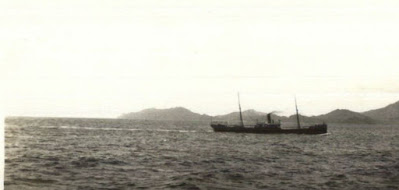(...) The most interesting spot in Macao is The Casa, commonly called Camoens Garden, a spacious demesne with beautifully wooded avenues of magnificent old trees. There are many mighty granite boulders with banyan trees so called apparently growing out of them the roots embracing them like cords. In a hollow in one of these boulders, Camoens the Portuguese poet who held the office of Administrator of the estates of his deceased countrymen in the middle of the sixteenth century is said to have composed the greater part of his poem The Lusiad. In an adjoining boulder some 20 feet from the ground lies the body of Camoen's mistress. The entrance to the tomb was indicated by an ornamental balcony now in ruins. A fine bronze bust of Camoens on a handsome pedestal has recently been placed below and on the face of the boulder are large bronze tablets on which are engraved extracts from the Lusiad. Recalled from Macao Camoens sailed for Goa suffered shipwreck and it is said that he only saved the manuscript of the Lusiad by holding it above his head in one hand while he swam ashore with the other. Camoens returned to Portugal and died at Lisbon in extreme poverty in the year 1579 in the 62nd year of his age. Nearly three centuries elapsed before his countrymen placed this memorial of him in the garden in which he had spent so many happy hours. There are some other monuments scattered about the garden one to the memory of Mrs John Theophilus Metcalfe whose husband spent six years in China. On the wall of the Casa grounds overlooking the inner harbour still remains the Observatory in which the scientific officers of La Perouse's squadron made Astronomical observations in January 1787. Among former residents in Macao was the Rev Dr Robert Morrison of world wide reputation as a Missionary and linguist. His great work the Chinese and English Dictionary was printed at Macao under the auspices of the East India Company.
Another remarkable resident was George Chinnery by birth, an Irishman by profession, an Artist whose works in portraits crayon sketches and paintings in oil are well known in Calcutta where he arrived in 1807. There are some fine specimens of his portraits in Government House and in the High Court Calcutta and his pencil and pen and ink sketches of native life and character are inimitable. Chinnery was a clever genial man but he was unhappily mated and was besides in trouble with his creditors so he disappeared from Calcutta and came to Macao where after a residence of 27 years he died on the 30th May 1852.
Jas B. Knight in The Indian Magazine nº 239, Novembro de 1890
O edifício do lado esquerdo é o Hotel Boa Vista referido pelo autor do artigo como sendo inaugurado na altura (1890)




Sem comentários:
Enviar um comentário